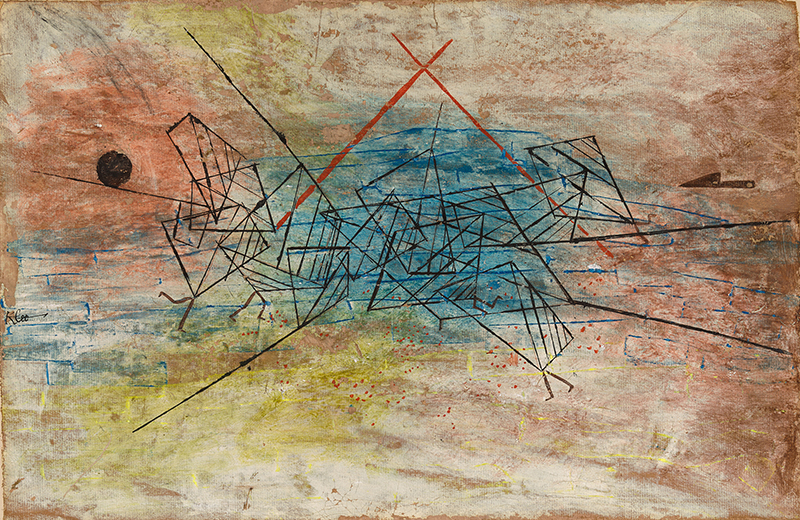Object of the Month: “Gefecht (Battle)” by Paul Klee
By Bowdoin College Museum of Art
The current exhibition of art and design from the Bauhaus, the revolutionary German art school that was founded on April 1, 1919, includes works by many members of the Bauhaus community. Whether they worked as graphic or industrial designers, sculptors, printmakers, or photographers, Bauhaus faculty and students grounded their creativity in the study of the foundations of art making: the properties of shapes and materials. In fact, for many teachers and students alike, experiments with and considerations of those very basics were at the core of their Bauhaus experience. They taught or participated in the Preliminary Course, the mandatory freshmen class that challenged creative minds to use their hands to play with and transform the most mundane things—scraps of wood, strings, wires, papers, and whatever else was available at no cost. Founding director Walter Gropius invited some of the most open-minded artists of the time, such as Wassily Kandinsky, Lyonel Feininger, and Paul Klee, to go back to the basics and, in collaboration with experienced crafts people, help train a new generation of creators who would rebuild society in a communal effort.
Founded in Weimar and successively moved to Dessau in 1925 and Berlin in 1932, the existence of the Bauhaus coincided with the Weimar Republic, the first and short-lived democracy in Germany. It was a period of extraordinary tensions and economic hardship. Emerging from World War I, Germans drew very different conclusions from the tragedy and consequently society polarized. Walter Gropius tried to steer clear of politics and asked students not to publicly take a stance, but in that highly politicized environment the obvious leftist aspirations of the Bauhaus made it an easy target for right-wingers nevertheless. To look back at the time one hundred years later makes more apparent than ever the extraordinary commitment of Bauhaus masters and students to remain productive. They responded to the political and socio-economic challenges with creativity, innovation, and a positive spirit
Paul Klee’s gouache Battle, one of the highlights of Bowdoin’s collection of works on paper, is currently on view in Modernism for All: The Bauhaus at 100. In the recent catalogue, Why Draw? 500 Years of Drawings and Watercolors curatorial assistant Honor Wilkinson discussed Klee’s “inventive use of line,” apparent in this work. “Rather than choosing figurative representation, he draws animated lines to suggest fighters in motion, re-creating his motif ‘parallel’ to nature. As a collection of overlapping, transparent, striped quadrangles, the combatants can be identified by their line-drawn feet. The carnal destruction is evident by the red specks underneath the bodies.” The curators of the current exhibition, Juliette Dankens ’18, Alex Dobbin ’18, and Danny Banks ’19, were equally fascinated by Klee’s use of abstraction. As they point out in their label for the work, the artist used his experience as teacher of the Preliminary Course from 1925 until 1930 to reflect on the formal elements of art and to refine his pedagogy. Klee, they write, “believed lines, created by a single point that set itself in motion, were their own beings; colors, too, functioned with autonomous personalities. This battle scene, defined by animated lines clashing in the center of the image on a backdrop of primary colors, is exemplary of Klee’s theories of line and movement.”
Klee’s work, now at Bowdoin, keeps teaching new generations about the findings of the Bauhaus masters. It also alerts viewers not to underestimate the power of art. Klee’s own signature on the left edge bears a little spear that points its hooked tip towards the combatants in the picture’s center. While the warriors don’t seem to notice the courageous little fellow, the detail will make attentive viewers smile.
Paul Klee, Swiss, 1879–1940, Gefecht (Battle), 1930, gouache on cardboard, Anonymous Gift, Bowdoin College Museum of Art
Joachim Homann, curator